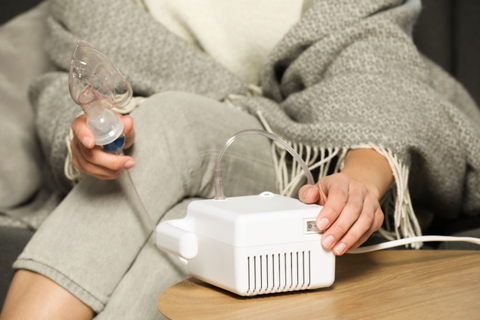At first glance, it’s puzzling: both drugs contain tobramycin, so why does the Bethkis inhalation solution cost significantly more than the Tobrex eye drops? The reasons come down to manufacturing complexity, regulatory processes, patient population, and market dynamics. Let’s dive in deeper;
1. Specialized Formulation for Inhalation
Inhalation solutions must be carefully engineered to reach deep into the lungs via nebulizer. This means:
-
The formulation must remain sterile for pulmonary delivery.
-
Particle sizes must be finely controlled to ensure proper deposition in the lower airways.
-
The drug must be stable over longer periods of use.
-
Compatibility with nebulizer systems must be ensured.
These requirements involve complex manufacturing, specialized equipment, and extensive testing—all of which drive up the cost.
Get Inmediate Copay Assistance
2. Small Target Patient Population
Tobramycin inhalation (Bethkis) is primarily used by patients with cystic fibrosis (CF) to treat chronic Pseudomonas aeruginosa lung infections. CF is a rare disease, and because the market size is small, pharmaceutical companies price each dose higher to recover development and production expenses.
Eye drops, on the other hand, are used to treat common conditions like conjunctivitis and blepharitis. They’re produced at much larger volumes and sold more widely, which lowers costs.
3. Different FDA Approval Pathways
Each route of administration requires its own FDA approval process:
-
Inhalation formulations underwent expensive and lengthy clinical trials to demonstrate safety and efficacy in CF patients.
-
Eye drops have been around longer and have multiple approved generics, which lowers the cost through competition.
4. Patent Protection and Competition
Tobramycin eye drops (Tobrex) are widely available in generic form from numerous manufacturers, which creates price competition. In contrast, inhalation products like TOBI and Bethkis were under patent or market exclusivity for years, and even now, only a few generic options exist—keeping prices high.
5. Distribution and Insurance Factors
Tobramycin inhalation is typically distributed through specialty pharmacies, like QuickRx, and may require prior authorization from insurance companies. This adds administrative complexity and cost. Eye drops are considered standard outpatient prescriptions, often covered by insurance with little or no copay—or available at low cash prices.
Need Tobramycin Copay Assistance?
Tobramycin Inhalation Solution (Bethkis): What You Need to Know
What It Treats:
Primarily used for chronic Pseudomonas lung infections in people with CF.
How It’s Used:
-
Inhaled via nebulizer twice a day, 12 hours apart
-
Typically prescribed in cycles: 28 days on, 28 days off
-
Should be used after airway clearance techniques like chest physiotherapy
Common Side Effects:
-
Hoarseness or voice changes
-
Ringing in the ears (tinnitus)
-
Cough, throat irritation
-
Wheezing, difficulty breathing
-
Bad taste in mouth
Serious Side Effects (Less Common):
-
Hearing loss (ototoxicity)
-
Bronchospasm
-
Kidney toxicity (rare)
-
Allergic reactions (rash, swelling, difficulty breathing)
Lifestyle Considerations:
-
Stay well-hydrated
-
Avoid exposure to tobacco or secondhand smoke
-
Continue all other prescribed CF therapies
-
Use a nebulizer specifically recommended for your medication
Monitoring Needs:
-
Regular hearing tests (audiometry)
-
Pulmonary function tests (PFTs)
-
In some cases, kidney function monitoring
Tobramycin Ophthalmic Solution (Tobrex Eye Drops): What You Need to Know
What It Treats:
Bacterial eye infections like conjunctivitis (pink eye), blepharitis, and keratitis.
How It’s Used:
-
Instill 1–2 drops into the affected eye(s) every 4–6 hours
-
In severe infections, use may increase to every 2 hours initially
-
Treatment typically lasts 5–7 days
Common Side Effects:
-
Temporary eye burning or irritation
-
Blurred vision (usually short-lived after application)
-
Watery eyes, redness, itching, or eyelid swelling
Serious Side Effects (Rare):
-
Allergic reactions
-
Superinfections if used long-term
-
Sensitization after repeated exposure
Lifestyle Considerations:
-
Wash hands before and after use
-
Don’t touch the dropper tip to any surface, including your eye
-
Avoid wearing contact lenses during treatment
-
Store the drops as directed—some may need refrigeration
Monitoring Needs:
-
Follow up with your eye doctor if symptoms worsen or don’t improve
-
Long-term users may need periodic eye exams
Side-by-Side Comparison
| Feature | Tobramycin Inhalation | Tobramycin Ophthalmic |
|---|---|---|
| Route | Inhaled via nebulizer | Drops applied to eyes |
| Primary Use | CF lung infections (Pseudomonas) | Bacterial eye infections |
| Treatment Duration | 28 days on, 28 off | 5–7 days |
| Common Side Effects | Hoarseness, cough, tinnitus | Eye irritation, blurred vision |
| Monitoring | Hearing tests, lung function | Follow-up for prolonged symptoms |
| Lifestyle Adjustments | Nebulizer use, airway clearance | Contact lens hygiene |
Final Thoughts for Patients
While both medications contain the same antibiotic, they are not interchangeable. Each form is tailored for a specific route of administration and type of infection, with different side effect profiles, treatment protocols, and monitoring needs.
If you are starting inhaled tobramycin, prepare for a more involved regimen that includes nebulizer use, regular pulmonary and hearing assessments, and potential insurance hurdles. For those prescribed the ophthalmic version, proper drop hygiene and short-term monitoring are key.
And if you’re facing high out-of-pocket costs for tobramycin inhalation, you’re not alone. Specialty pharmacy support and copay assistance programs can help—and QuickRx is here to guide you.
Need Help Managing Cost or Access?
Contact QuickRx Specialty Pharmacy for:
-
Copay assistance programs
-
Insurance navigation
-
Access to experienced pharmacists who understand tobramycin therapy
-
Reliable, nationwide delivery
We know how complex treatment can be—especially when cost is a barrier. Let QuickRx help make your journey easier.
Always consult your doctor or pharmacist before making any changes to your medication. If cost is a factor, contact QuickRx immediately—we may be able to help.


